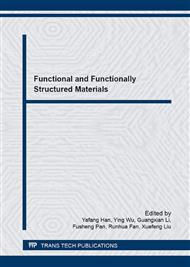[1]
Qiangqiang Guo, Huimin Xiang, Xin Sun, Xiaohui Wang, Yanchun Zhou, Preparation of porous YB4 ceramics using a combination of in-situborothermal reaction and high temperature partial sintering, Journal of the European Ceramics Society. 35(2015).
DOI: 10.1016/j.jeurceramsoc.2015.05.023
Google Scholar
[2]
Dongxu Yao, Yongfeng Xia, Yu-Ping Zeng,Kai-hui Zuo, Dongliang Jiang, Fabrication porous Si3N4 ceramics via starch consolidation-freeze drying process, Materials Letters. 68(2012) 75-77.
DOI: 10.1016/j.matlet.2011.09.092
Google Scholar
[3]
Hai-Long Hu, Yu-Ping Zeng. High-strength porous Si3N4 ceramics prepared by freeze casting and silicon powder nitridation process, Materials letters. 133(2014) 285-288.
DOI: 10.1016/j.matlet.2014.06.176
Google Scholar
[4]
Rubing Zhang, Daining Fang, Microstructure and properties of highly porous Y2SiO5 ceramics produced by a new water-based freeze casting, Materials&Design. 46(2013) 746-750.
DOI: 10.1016/j.matdes.2012.11.020
Google Scholar
[5]
Rubing Zhanga, Bingyu Hana, Daining Fangb, Yuesheng Wanga. Porous Y2SiO5 ceramics with a centrosymmetric structure produced by freeze casting, Ceramics international. 41(2015) 11517-11522.
DOI: 10.1016/j.ceramint.2015.05.099
Google Scholar
[6]
Guogang Xua, Jian Lia, Biotemplated fabrication of porous alumina ceramics with controllable pore size using bioactive yeast as pore-forming agent, Ceramics international. 41(2015) 7042-7047.
DOI: 10.1016/j.ceramint.2015.02.007
Google Scholar
[7]
S Deville, E Saiz, RK Nalla, AP. Tomsia, Freezing as a path to build complex composites, Science. 311(2006) 515-518.
DOI: 10.1126/science.1120937
Google Scholar
[8]
CQ Hong, JC Han. Novel nanoporous silica aerogel impregnated highly porous ceramics with low thermal conductivity and enhanced mechanical properties, Scripta Materialia. 68(2013) 599-602.
DOI: 10.1016/j.scriptamat.2012.12.015
Google Scholar
[9]
ZG Hou, JC Liu. Preparation of porous Y2SiO5 ceramics with relatively high compressive strength and ultra-low thermal conductivity by a TBA-based gel-casting method, Ceram. Int. 39(2013) 969-976.
DOI: 10.1016/j.ceramint.2012.07.014
Google Scholar
[10]
XM Li, PT Wu, DL. Zhu, Properties of porous alumina ceramics prepared by technique combining cold-drying and sintering, Int. J. Retract. Met. Hard Mater. 41(2013) 437-441.
DOI: 10.1016/j.ijrmhm.2013.05.020
Google Scholar
[11]
LF Hu, CA Wang. Control of pore channel size during freeze casting of porous YSZ ceramics with unidirectionally aligned channels using different freezing temperatures, J. Eur. Ceram. Soc. 30 (2010) 3389-3396.
DOI: 10.1016/j.jeurceramsoc.2010.07.032
Google Scholar
[12]
Gang Liu, Dou Zhang, Carl Meggsa, Tim W. Buttona. Porous A12O3-ZrO2 composites fabricated by an ice template method, Scripta Materialia. 62(2010) 466-468.
DOI: 10.1016/j.scriptamat.2009.12.018
Google Scholar
[13]
Dongxu Yao, Yongfeng Xia. Gradient porous silicon nitride prepared via vacuum foaming and freeze drying, Materials Letters. 141(2015) 138-140.
DOI: 10.1016/j.matlet.2014.11.067
Google Scholar
[14]
Sung-tag OH, Si-young Chang, Microstructure of porous Cu fabricated by freeze-drying pro- cess of CuO/camphene slurry, Transactions of Nonferrous Metals Society of China. 22(2012) 688-691.
DOI: 10.1016/s1003-6326(12)61787-7
Google Scholar
[15]
Kai Hui Zuo, Yuping Zeng, Dongliang Jiang, Effect of cooling rate and polyvinyl alcohol on the morphology of porous hydroxyapatite ceramics, Materials&Design. 31(2010) 3090-3094.
DOI: 10.1016/j.matdes.2009.12.044
Google Scholar
[16]
Sylvain Deville, Eduardo Saiz, Antoni P. Tomsia. Freeze casting of hydroxyapatite scaffolds for bone tissue engineering, Biomaterials. 27(2006) 5480-5489.
DOI: 10.1016/j.biomaterials.2006.06.028
Google Scholar
[17]
James A. SearlesE, Annealing to Optimize the Primary Drying Rate, Reduce Freezing -Induced Drying Rate Heterogeneity, and Determine Tg in Pharmaceutical Lyophilization, Journal of pharmaceutical sciences. 90(2001) 872-887.
DOI: 10.1002/jps.1040
Google Scholar
[18]
Wassim Abdelwahed, Ghania Degobert, Hatem Fessi. Freeze-drying of nanocapsules: Impact of annealing on the drying process, International Journal of Pharmaceutics. 324(2006) 74-82.
DOI: 10.1016/j.ijpharm.2006.06.047
Google Scholar


